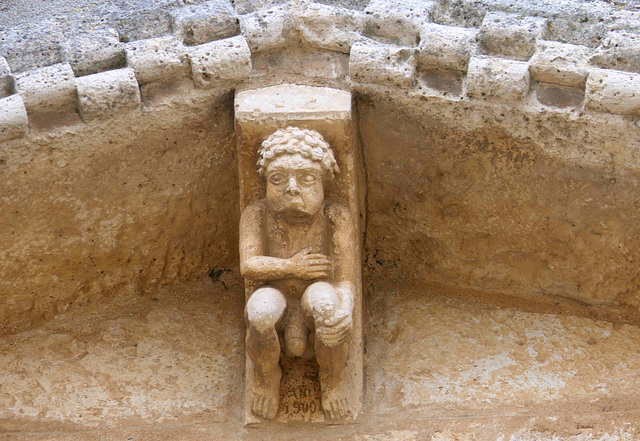Valencia - Catedral de Santa María
Rodeiro - Igrexa de San Vicente
Pantón - San Fiz de Cangas
Bishopstone - St Andrews
Agen - Cathédrale Saint-Caprais d'Agen
Ferrara - Cattedrale di San Giorgio
Soulosse-sous-Saint-Élophe - Saint-Élophe
Saint-Marcel - Saint-Marcel
Cambia - San Quilico
Le Monastier-sur-Gazeille - Saint Chaffre
Saint-Jean-de-Côle - Saint-Jean-Baptiste
Saint-Jean-de-Côle - Saint-Jean-Baptiste
Vouthon - Saint-Martin
Macqueville – Saint-Étienne
Benet - Sainte-Eulalie
Saint-Quantin-de-Rançanne - Saint-Quantin
Saint-Quantin-de-Rançanne - Saint-Quantin
Saint-Quantin-de-Rançanne - Saint-Quantin
Modena - Duomo di Modena
Poursay-Garnaud - Notre Dame
Poitiers - Sainte-Radegonde
Villers-Saint-Paul - Saint-Pierre-et-Saint-Paul
Villers-Saint-Paul - Saint-Pierre-et-Saint-Paul
Burgos - Cathedral
Vienne-en-Bessin - Saint-Pierre
Vienne-en-Bessin - Saint-Pierre
Melle - Saint-Savinien
Montils - Saint-Sulpice
Champagnolles - Saint-Pierre
Champagnolles - Saint-Pierre
Champagnolles - Saint-Pierre
Champagnolles - Saint-Pierre
Champagnolles - Saint-Pierre
Location
See also...
Keywords
Authorizations, license
-
Visible by: Everyone -
All rights reserved
-
18 visits
Frómista - San Martín


Today Frómista has a population of less than 1000. In previous centuries, Frómista had a significant population that lived from growing wheat.
A church and a Benedictine monastery on this site were first mentioned in the will of Queen Munia Mayor, widow of King Sancho III of Navarre, in 1066. The queen made the monastery and church partial heirs to her fortune. This fortune made possible the construction of a magnificent church, which was built in the last third of the 11th century in a construction period of 15 to 20 years, continuously and without interruption. Close links exist with the Cathedral of Jaca and the Basilica of San Isidoro, the craftsmen appear to have been partly the same.
In 1118, Queen Urraca, a great-granddaughter of Queen Munia, placed the church, monastery and associated settlement, San Martín, under the authority of the monastery of San Zoilo. San Martín thus became the priory of this monastery. Throughout the following Middle Ages, there were constant disputes between the town of Frómista and the monastery of San Zoilo over rights in and to the village of San Martín, which even led to military conflicts. It was not until 1488 that the dispute was settled.
In 1453, a Host miracle occurred in San Martín. The paten used and the host was venerated in the church until the 19th century.
From 1896 to 1904, the church was extensively restored. The restoration, which aimed to recreate a "perfect" Romanesque church, is highly controversial today.
The figure with the large phallus may have been restored in 1900 (inscription). The genitals of such sculptures were often cut off during later Puritan times.
A church and a Benedictine monastery on this site were first mentioned in the will of Queen Munia Mayor, widow of King Sancho III of Navarre, in 1066. The queen made the monastery and church partial heirs to her fortune. This fortune made possible the construction of a magnificent church, which was built in the last third of the 11th century in a construction period of 15 to 20 years, continuously and without interruption. Close links exist with the Cathedral of Jaca and the Basilica of San Isidoro, the craftsmen appear to have been partly the same.
In 1118, Queen Urraca, a great-granddaughter of Queen Munia, placed the church, monastery and associated settlement, San Martín, under the authority of the monastery of San Zoilo. San Martín thus became the priory of this monastery. Throughout the following Middle Ages, there were constant disputes between the town of Frómista and the monastery of San Zoilo over rights in and to the village of San Martín, which even led to military conflicts. It was not until 1488 that the dispute was settled.
In 1453, a Host miracle occurred in San Martín. The paten used and the host was venerated in the church until the 19th century.
From 1896 to 1904, the church was extensively restored. The restoration, which aimed to recreate a "perfect" Romanesque church, is highly controversial today.
The figure with the large phallus may have been restored in 1900 (inscription). The genitals of such sculptures were often cut off during later Puritan times.
Annemarie has particularly liked this photo
- Keyboard shortcuts:
Jump to top
RSS feed- Latest comments - Subscribe to the comment feeds of this photo
- ipernity © 2007-2024
- Help & Contact
|
Club news
|
About ipernity
|
History |
ipernity Club & Prices |
Guide of good conduct
Donate | Group guidelines | Privacy policy | Terms of use | Statutes | In memoria -
Facebook
Twitter

Sign-in to write a comment.